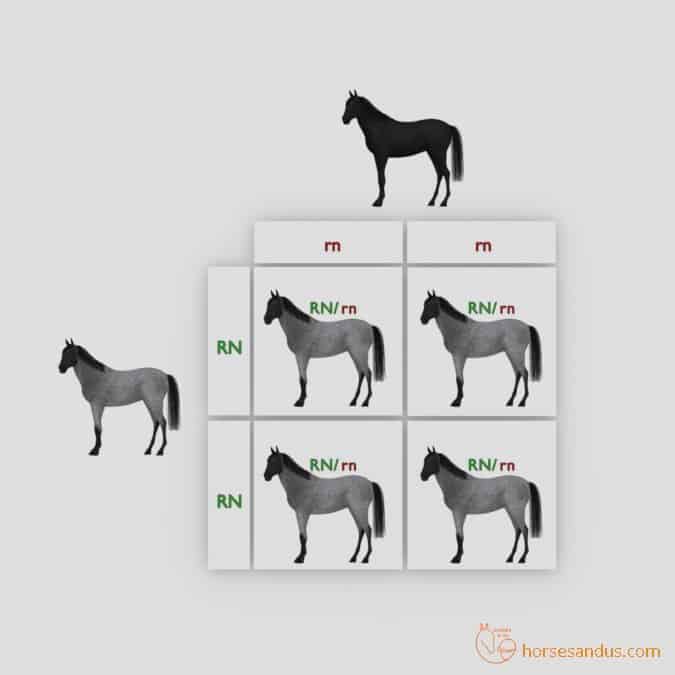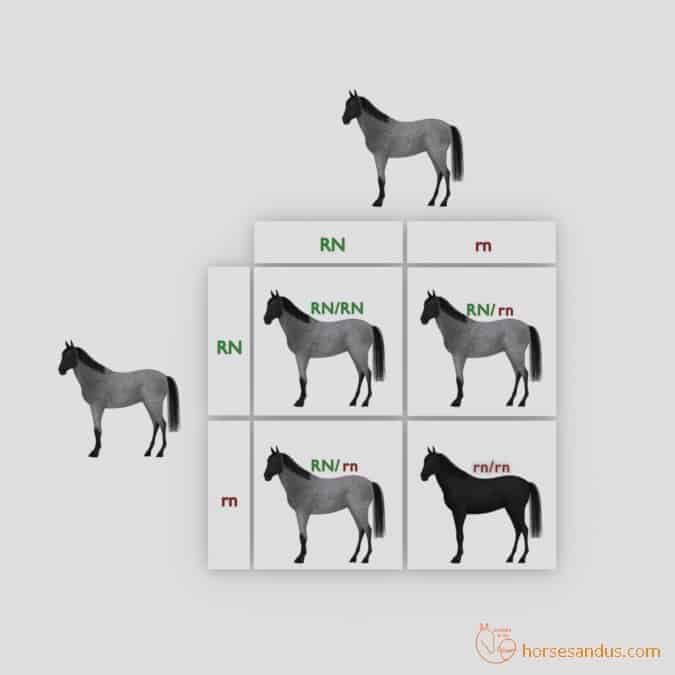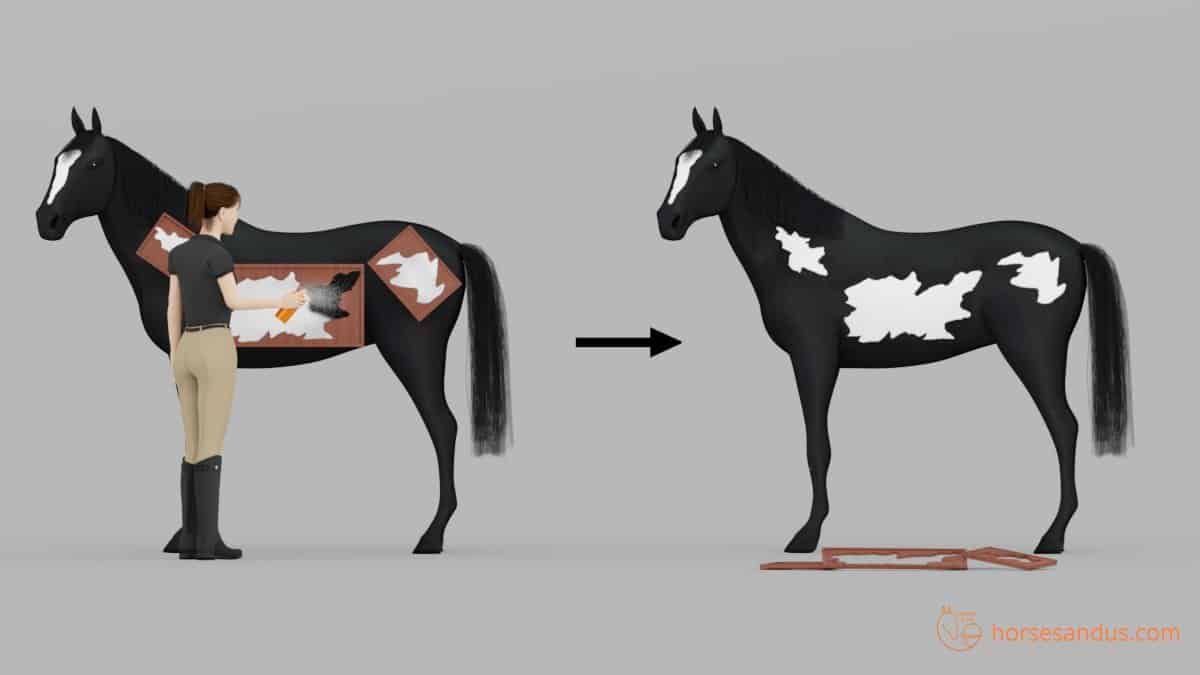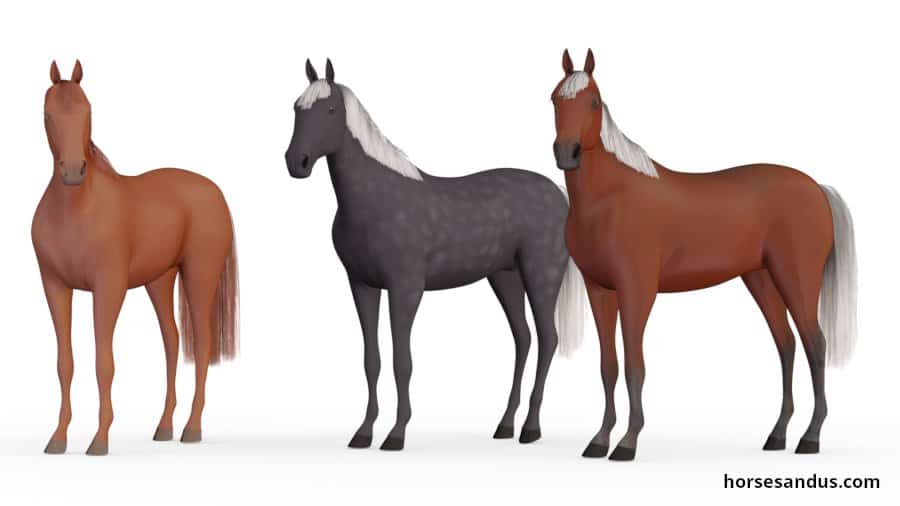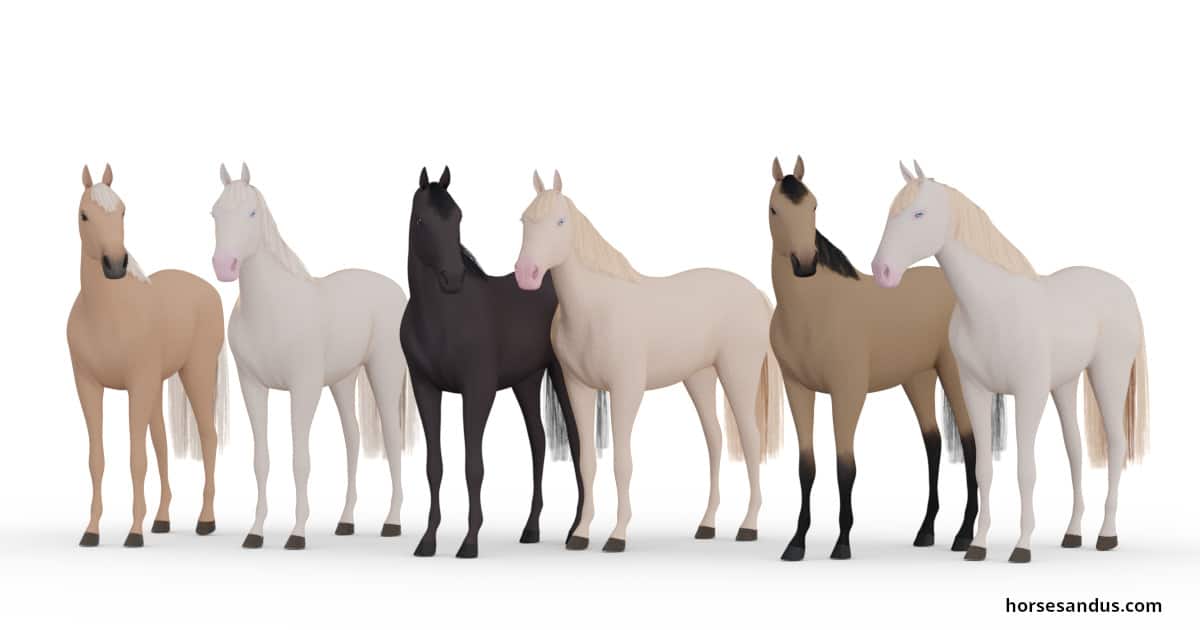A Roan horse also called “True Roan” or “Classic Roan,” is characterized by a white pattern where colored hairs are evenly intermixed with white hairs, producing a silvering effect. This intermixture of white hairs occurs only on the body, leaving the head, lower leg, mane, and tail with the horse’s base coat color.
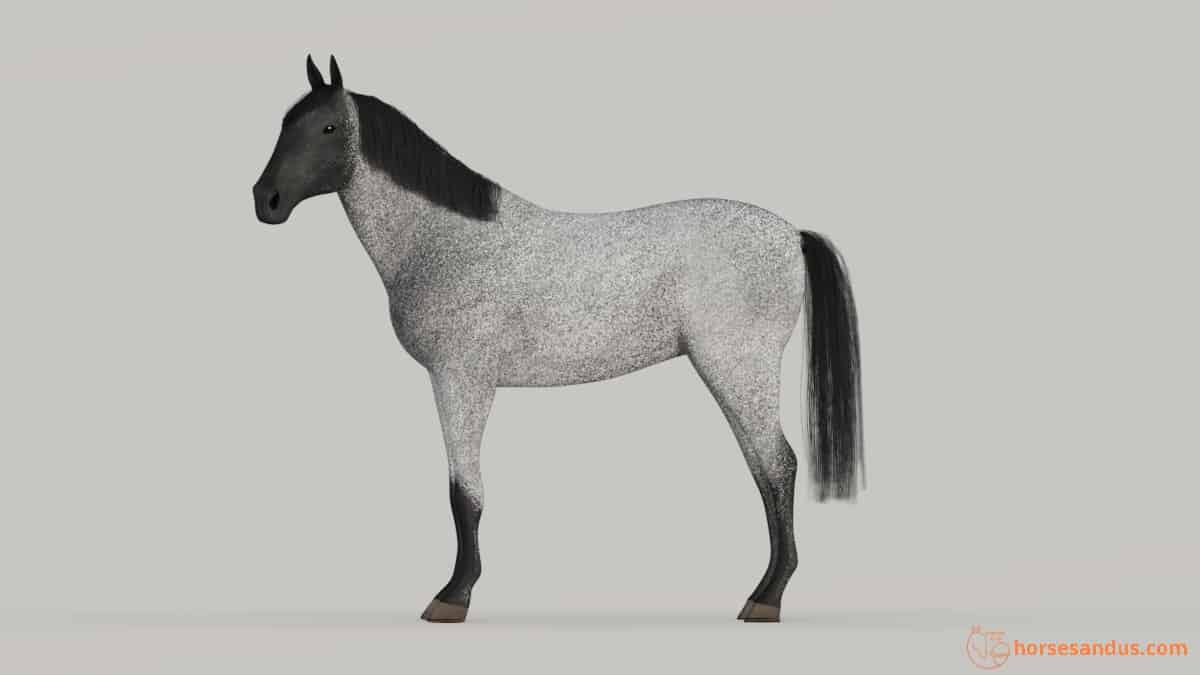
The expression of the roan pattern can vary from minimal to extensive, just like with other white patterns.
There is a huge variety of horse coat colors and patterns. In this article, we will look at the pattern produced by the Roan gene.
Characteristics Of Roan Horses
The 7 following characteristics will help you identify a Roan horse:
1. Intermixture of white hairs in Roan horses
Roan horses have an intermixture of white hairs across the body, but the head and points (mane tail and lower legs) are a mostly solid color with only a few white hairs scattered or even none at all.
In minimal expressions of the Roan gene, the roaning will only exist over the croup and hip area.
2. Roans Have An Inverted V Shape On The Legs
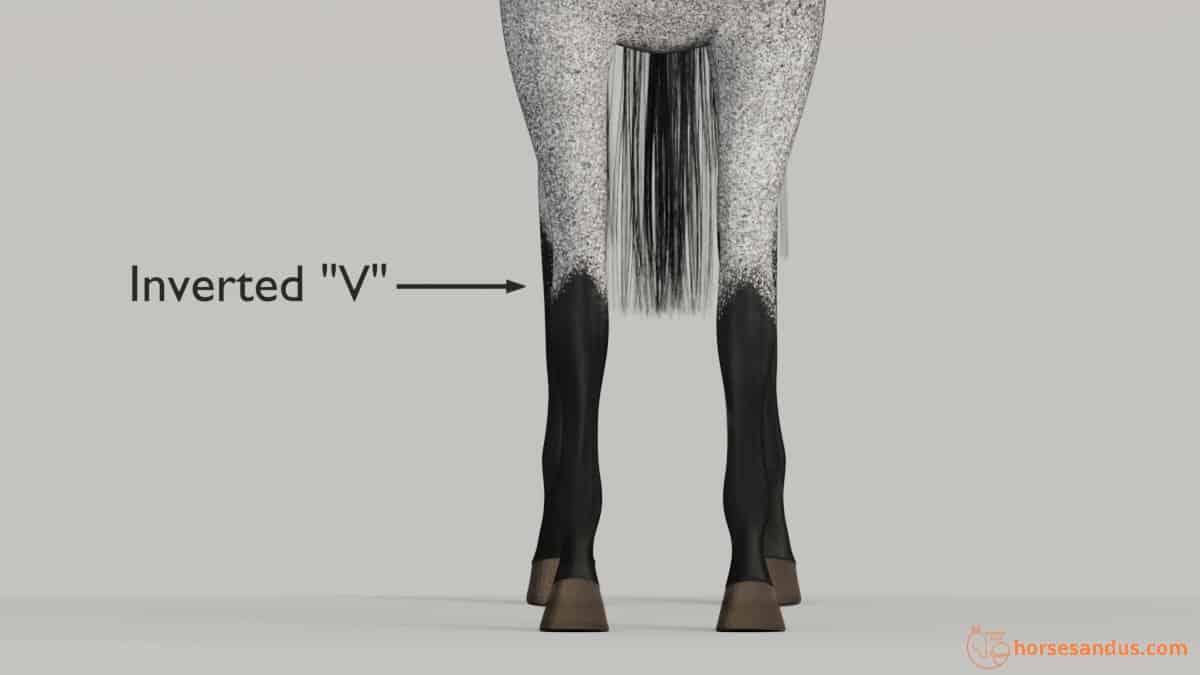
There is typically an inverted V shape on the legs, like a spear, where the roaned pattern ends and the solid color begins. When the solid color is light, like, for example, palomino or buckskin, it is almost impossible to see the effect of roaning on the body. So this inverted V shape is the only way to identify the roan pattern.
3. Scars In Roan Horses Heal With Colored Hair
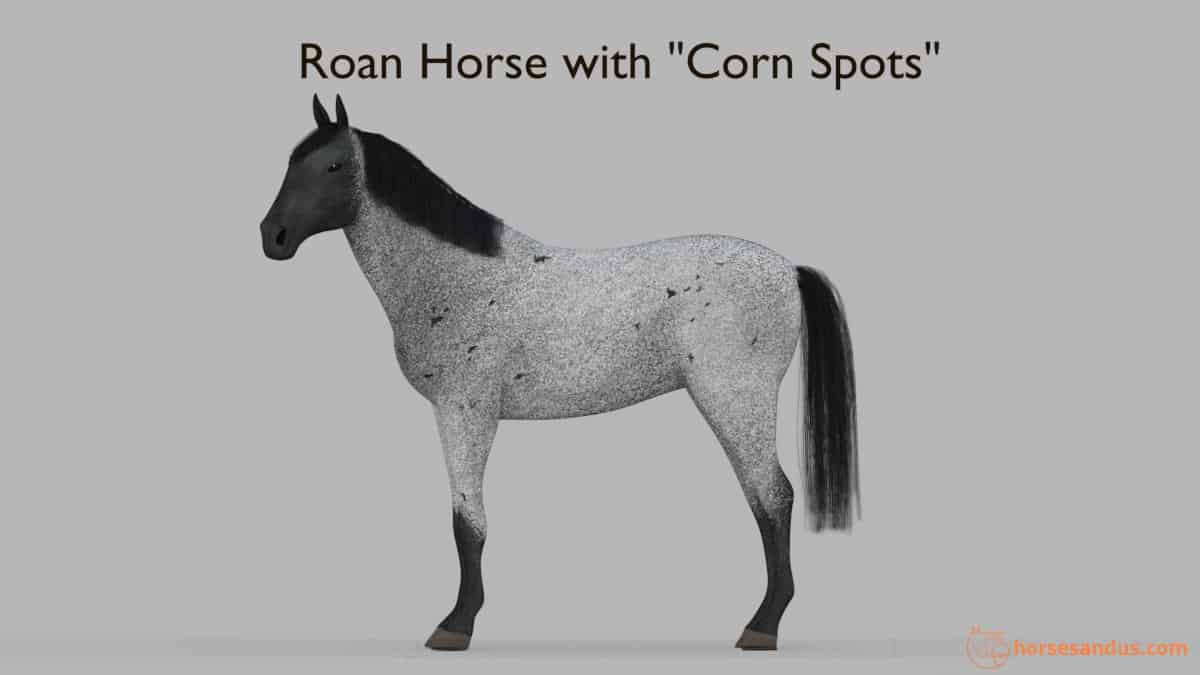
The “corn spots” are another interesting clue to identify a Roan horse. When a roan horse is injured, the scars will heal with colored hair instead of white hair like most other horses.
These colored hair scars are called “corn spots.” For example, a chestnut roan´s scar will have red hair. Contrarily, a chestnut horse´s scar will have white hair.
However some roan horses have dark spots that are not the result of scarring, and in these cases, they are also called corn spots.
4. Roan Horses Can Have Reversed Dapples

Roan horses rarely have dapples, but when they do, they are reversed. The reversed dapples are darker than the surrounding areas, which is the opposite of the normal dapples, which are lighter than the surrounding areas.
5. The “Roaning” varies between Seasons
The amount of white varies between seasons. When the coat is shed in the spring and summer, the roaning pattern is more visible than in the cold seasons when they have the darker winter coat. This is because the long, harsh hairs of the winter coat seem to be less affected by roan than the short hairs of the summer coat.
The Icelandic term for Roan is “litförótt,” which means “always changing color.”
6. Roan Horses darken With Age
Roan horses’ coat becomes darker as they age, the opposite of grey horses that get lighter with age. It can be so extreme that some roans look like solid-colored horses later in life. This seems to affect the mares more than stallions and geldings.
7. Roan Horses Are Born Roan
The roaning pattern is present since birth, but it may not be easily seen until the first foal coat is shed. This is not due to a progressive silvering process like the grey horses. It is because of the characteristics of the first coat of the foal.
The Roan Pattern Over Different Coat Colors
The Roan pattern can occur with any base coat color (black, chestnut, bay) or diluted coat color (dun, cream, silver, or champagne).
There are different names used for roan horses, depending on their base color.
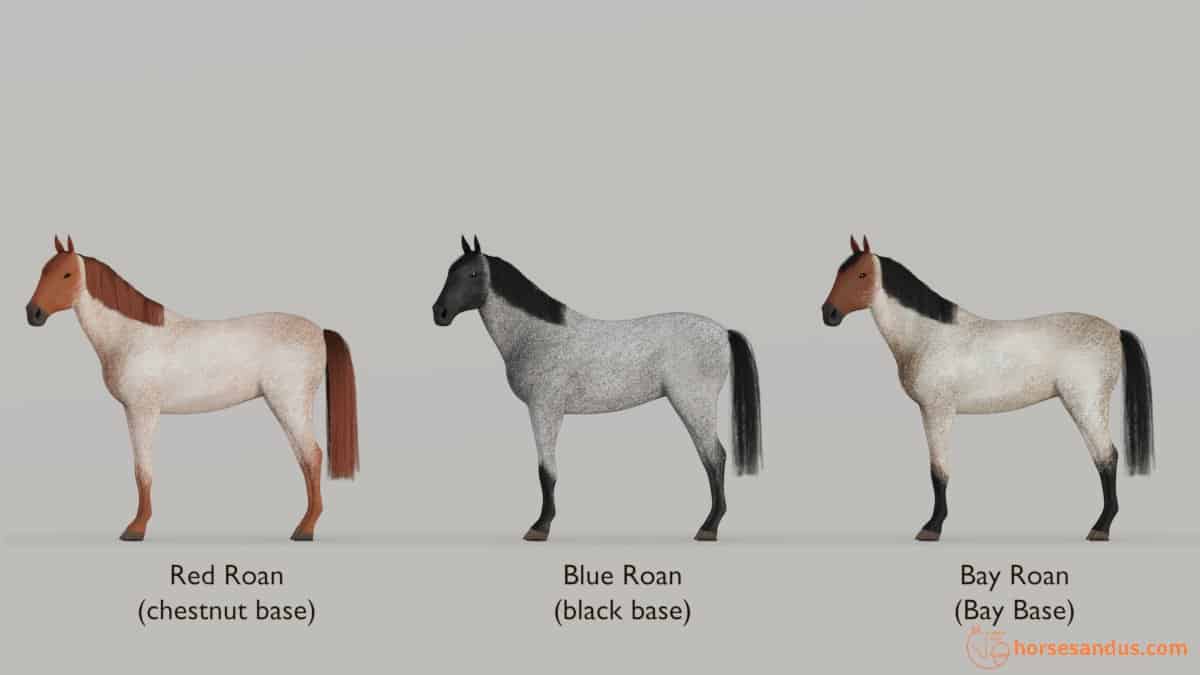
Red Roan Horse (Chestnut Base)
Red Roan is when the roan pattern is combined with the chestnut base color.
When combined with a light chestnut, the coat has a pinkish color, and is often called “strawberry roan”.
In the case of a dark chestnut color, the coat has a purplish color, and is often called “lilac roan”.
Blue Roan Horse (Black Base)
Blue Roan is when the roan pattern is combined with the black base color.
The silvering effect on a black base color, gives the impression of a bluish tint, hence the name blue roan.
But some people call these black roans instead.
Bay Roan Horse (Bay Base)
Bay Roan is when the roan pattern is combined with the bay base color.
The effect is quite interesting, with a pinkish body, a red head, and black points (mane tail and lower legs).
In the past, bay roans and red roans were grouped together and both were called red roans.
Roan Over Other Coat Colors
The three variations described above are the most common ones, but roan can be combined with virtually any color. In these cases, the roans are named by combining the background color with roan. Like for example, Palomino Roan, Buckskin Roan, Dun Roan, and so on.
When Roan is combined with some diluted colors like Palomino, cremello, etc, or with grey, or with other white color patterns, it is not very visible and sometimes is impossible to see.
It can also exist in conjunction with other white patterns (Frame, Sabino, Tobiano, Splashed White, Dominant White, or Leopard Complex).
Similarities Of Roan With Other Coat Patterns
Other white patterns are often confused with the true or classic Roan. But the main characteristics that distinguish all these roaned patterns from the Classic Roans are the colored face and lower legs and the inverted V on the knees typical in Classic roans.
Roan vs Grey
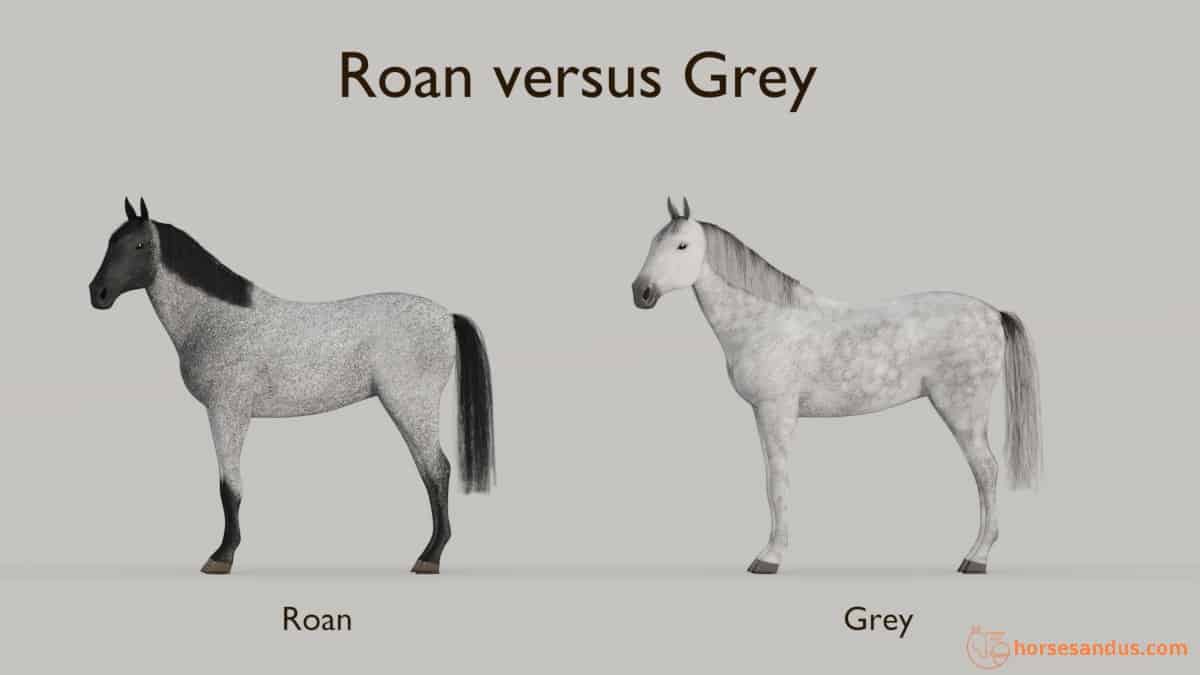
Grey is one of the patterns that are most confused with roan. The confusion is due to the similar intermixing of white and colored hairs. However, Grey is not a white pattern like roan. It is instead a modifier that causes a progressive whitening of the horse´s hair throughout its lifetime.
A grey horse can change from a completely colored foal to a completely white horse. Contrarily Roan horses keep the amount of white hairs stable during all the life of the horse. In some cases, Roan horses can even darken with age.
Another difference is that the head of the roan horses is typically colored, but in grey horses, it will have a similar intermix of hairs as the rest of the body. The progressive greying is made uniformly across the body and head.
Roan vs Rabicano
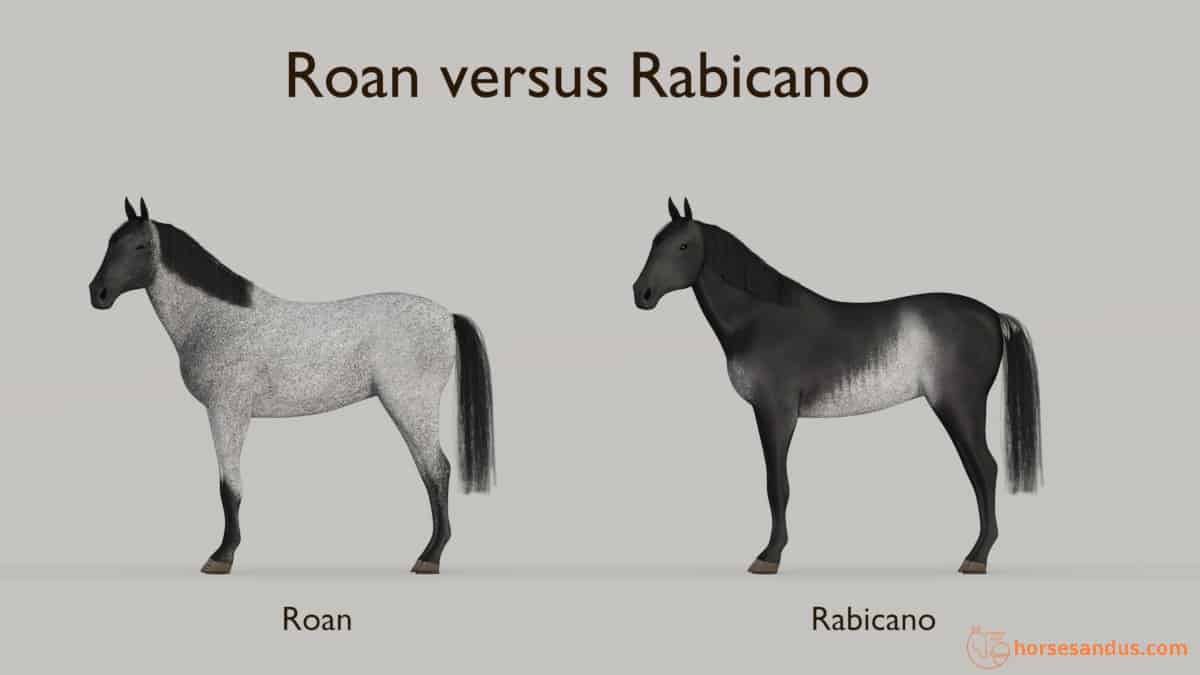
Rabicano, or “white ticking” is often mistaken for Roan. However, Roan will distribute the intermix of white hairs evenly across the body but leaving out the extremities (the head and lower legs). Differently, the Rabicano will have an uneven distribution of the intermixed hairs and will be more concentrated on the flank, belly, and base of the tail.
The usual term for this pattern in English is white ticking, but it can also be called “skunk tail” due to the presence of white hairs on the base of the tail. The term Rabicano is used in Spanish.
The genetics behind the Rabicano pattern is not yet fully understood, and more studies still need to be done.
Roan vs Varnish Roan

The Leopard Complex gene (appaloosa) may also have a roaning effect called varnished roan. This roaning can also be mistaken for the classic roan.
However, the varnish roan has an uneven distribution of patches of intermixed hair across the body (including the head and lower legs), leaving color on the bony parts of the face, knees, hips, and stifle. These colored spots are called “varnish marks.”
This pattern can be spread throughout the entire body or just over the rump, in which case it is called a “varnish blanket”.
Differently, the classic roan has an even distribution of roan throughout the body, regardless of the bony parts, and presents a colored head and lower legs.
Another distinguishing feature is that varnish roans have white eye sclera, striped hooves, and mottled skin around the eyes and muzzle.
The Genes Behind Roan

The KIT gene in horses is responsible for many different white patterns. These white patterns can be grouped into four different variants of the Kit gene: Sabino(SB1), Tobiano(TO), Roan(RN), and Dominant White(W).
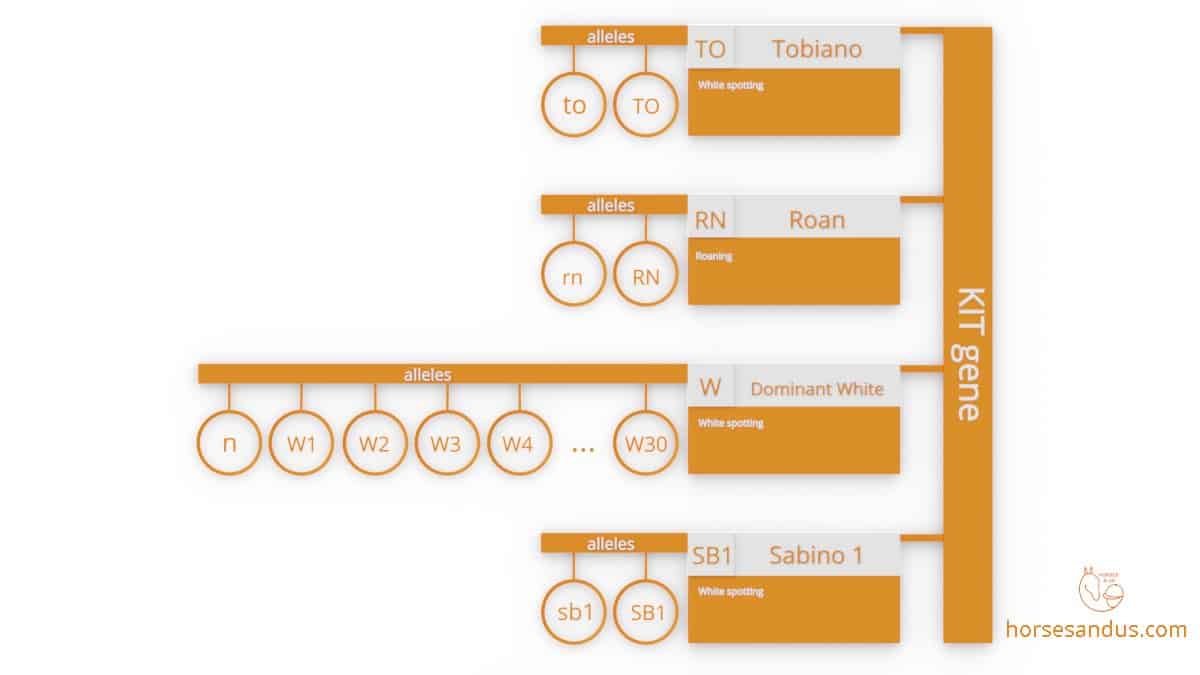
The Roan pattern is represented by the symbol “RN”, which is also used to represent the dominant allele. The recessive allele, absence of roan, is represented by the lowercase symbol “rn”.
As RN is dominant, only one copy of the allele is needed to express the roan pattern. Heterozygous and homozygous Roans have identical appearances.
Combinations of White Patterns from Kit Gene
Although the KIT gene is responsible for four different white patterns, it is actually only one gene. Therefore, a horse cannot carry more than two alleles from that gene (one inherited from the sire and the other from the dam).
So, for example, we can have genotypes with only the Roan allele RN/RN or RN/rn or genotypes that cross different alleles in the KIT gene, like, for example, RN/TO, RN/W1, or RN/SB1.
Homozygous Roan (RN/RN) cannot carry any of the other KIT mutations: Dominant White, Sabino1, or Tobiano
Adding Layers Of Other White Pattern Genes
However, horses can additionally carry other white pattern genes, like Splashed White and Frame Overo, because these white patterns are produced by other genes.
In conclusion, it is possible to add successive layers of white patterns, as long as each layer is caused by a different gene.
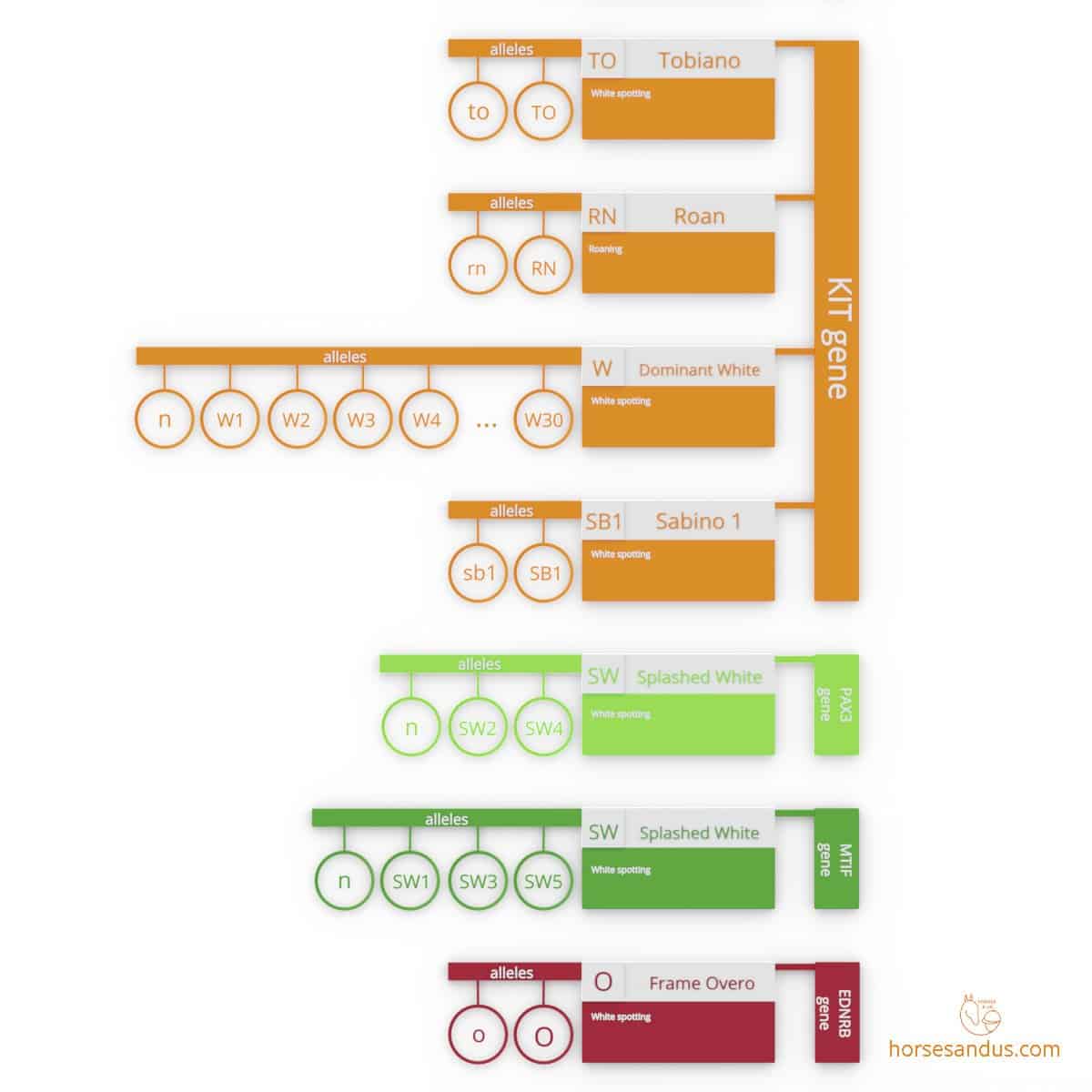
Roan Genes Inheritance
Roan is inherited as a Simple Dominant. This means that if a horse is Roan, then at least one of the parents must have been Roan as well.
- RN Dominant allele
- rn recessive allele
- rn/rn the horse will not have Roan white pattern
- RN/rn heterozygous Roan. The horse will have a typical Roan pattern
- RN/RN homozygous Roan. The horse will have a typical Roan pattern, and in the past believed to be embryonic lethal.
Using the following Punnett Squares we can see the possible outcomes for foals based on different genotypes of the parents.
Breeds Where We Can Find The Roan Pattern
The classic roan pattern is found in many breeds worldwide.
It is common in:
- European draft breeds like Ardennes, Trait Du Nord, Italian Heavy Draft, Belgium, and Rhenish-German Cold-Blood.
- European ponies like Dales Ponies, Welsh Ponies, Gypsy Cobs, Shetland Ponies, Connemara ponies, and New Forest ponies. Also present in Icelandic horses and Miniature horses.
- North American breeds like Quarter Horse, Paint Horse, Peruvian Paso, Paso Fino, Standardbred, Mustang, and Tennessee Walking Horse.
And in many more breeds.
Are Homozygous Roans embryonic lethal?
For many years it was believed that homozygous roans (RN/RN) were embryonic lethal, i.e., a non-viable embryo that would abort.
This was based on a study back in 1979 of Belgian horses, where researchers observed that mating two roan parents would produce fewer offspring than expected. However, this has been disproven, based on similar studies with American Quarter horses that did not produce the same results as the first study.
Additionally, this belief has been proven false based on genetic tests that can now indirectly detect if a horse has the roan gene and how many copies.
With further research, we may discover that there is more than one mutation responsible for the Classic Roan pattern. There may be different mutations in different breeds, like the W series in the KIT gene. This might explain why some RN homozygous are lethal, and others may be viable.
So we should not yet throw away the possibility that there may be a certain Roan mutation that does, in fact, cause embryonic lethal.
Further Reading
If you would like to learn more about horse colors and white patterns, you may want to read the following books, available on amazon.
The links below that lead to products on Amazon are affiliate links and I earn a commission (with no additional cost for you) if you make a purchase.
These books are an introduction to horse colors and white patterns which are full of images and very easy to understand.
The Equine Tapestry: An Introduction to Colors and Patterns The Ultimate Guide to Horse ColorsA more technical book about horse colors, but still very easy to understand.
Equine Color GeneticsSources
https://www.aqha.com/-/horse-breeding-the-roan-quarter-horse-color
https://vgl.ucdavis.edu/test/roan
https://link.springer.com/article/10.1007/s003359900987
Equine Color Genetics 4th Edition by D- Philip Sponenberg

